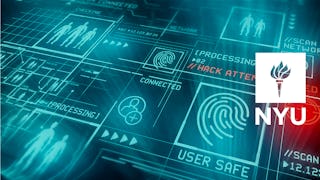Introduction of basic principles and applications of cybersecurity. Topics include symmetric and asymmetric encryption and decryption algorithms, hashing techniques, digital certificates, digital signatures, message authentication codes, authentication, malware, and security of systems such as networks, operating systems, software, and databases.

Unlock access to 10,000+ courses with Coursera Plus. Start 7-Day free trial.

Skills you'll gain
Details to know

Add to your LinkedIn profile
7 assignments
See how employees at top companies are mastering in-demand skills

There are 5 modules in this course
This module provides an overview of the basic concepts of cryptography, including encryption, decryption, and cryptographic algorithms. It lays the groundwork for understanding the principles and practices of secure communication.
What's included
8 videos4 readings1 assignment1 discussion prompt
This module introduces various mathematical theorems related to number theory that are extensively used in asymmetric encryption algorithms.
What's included
4 videos2 readings1 assignment
This module delves into historical encryption methods such as Caesar cipher, monoalphabetic substitution, and transposition techniques. It explores their strengths and weaknesses, providing context for modern cryptographic techniques.
What's included
8 videos1 reading2 assignments
Focusing on block ciphers, this module introduces DES as a foundational symmetric encryption algorithm. It discusses its structure, modes of operation, and its significance in cryptographic history.
What's included
6 videos1 reading1 assignment
Building upon the discussion of DES, this module introduces the AES algorithm, which has become the standard for symmetric encryption. It covers its design principles, security features, and its adoption as a global encryption standard.
What's included
5 videos1 reading2 assignments
Build toward a degree
This course is part of the following degree program(s) offered by Ball State University. If you are admitted and enroll, your completed coursework may count toward your degree learning and your progress can transfer with you.¹
Instructors


Offered by
Explore more from Computer Security and Networks
 Status: Free Trial
Status: Free TrialUniversity of Colorado System
 Status: Free Trial
Status: Free Trial Status: Preview
Status: PreviewUniversity of London
 Status: Free Trial
Status: Free TrialNew York University
Why people choose Coursera for their career





Open new doors with Coursera Plus
Unlimited access to 10,000+ world-class courses, hands-on projects, and job-ready certificate programs - all included in your subscription
Advance your career with an online degree
Earn a degree from world-class universities - 100% online
Join over 3,400 global companies that choose Coursera for Business
Upskill your employees to excel in the digital economy
Frequently asked questions
To access the course materials, assignments and to earn a Certificate, you will need to purchase the Certificate experience when you enroll in a course. You can try a Free Trial instead, or apply for Financial Aid. The course may offer 'Full Course, No Certificate' instead. This option lets you see all course materials, submit required assessments, and get a final grade. This also means that you will not be able to purchase a Certificate experience.
When you purchase a Certificate you get access to all course materials, including graded assignments. Upon completing the course, your electronic Certificate will be added to your Accomplishments page - from there, you can print your Certificate or add it to your LinkedIn profile.
Yes. In select learning programs, you can apply for financial aid or a scholarship if you can’t afford the enrollment fee. If fin aid or scholarship is available for your learning program selection, you’ll find a link to apply on the description page.
More questions
Financial aid available,

